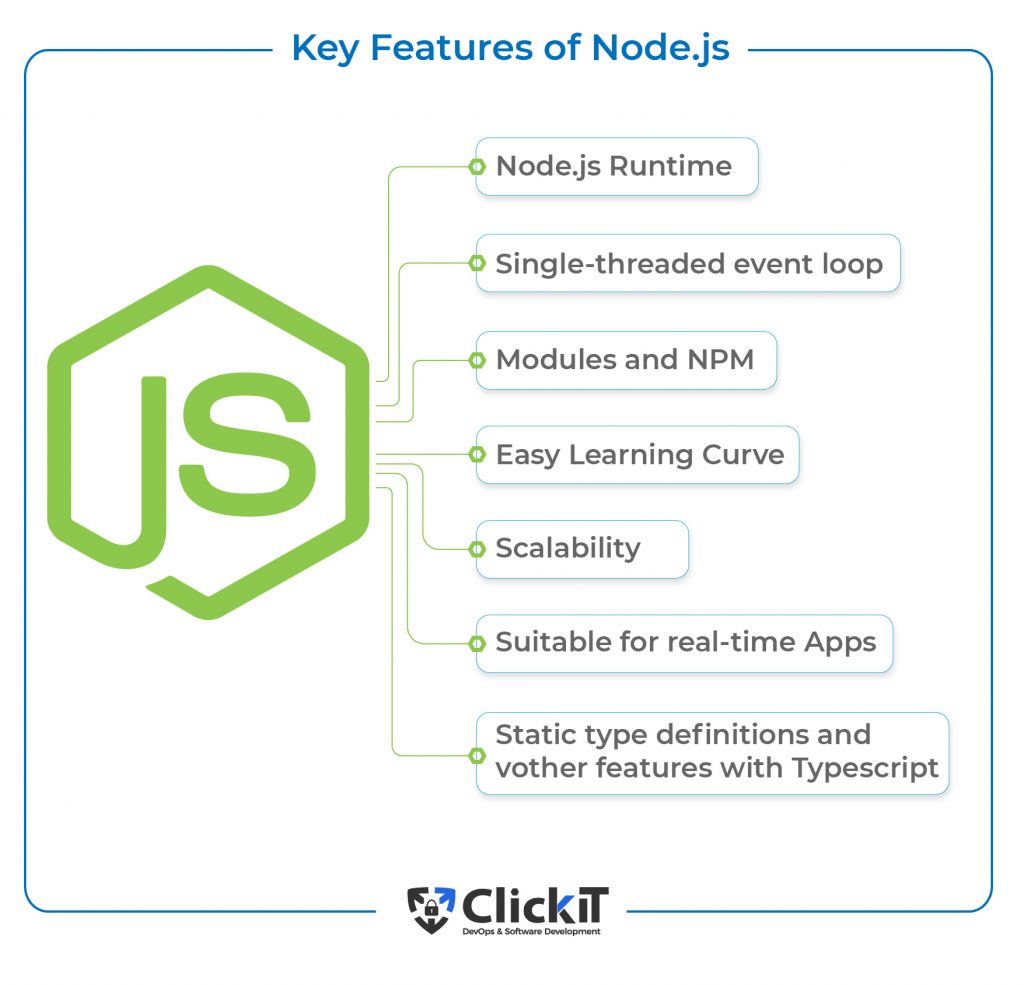Comparing Node js vs Python is a hot topic these days. According to Statista.com, 48.24% of programmers use Python, while 33.91% use Node.js worldwide as of 2023-2024. However, higher usage does not always mean it is the best technology, nor does low usage mean it’s not promising. So, when selecting one, we need to do it based on our requirements and analyze Python vs Nodejs performance.
Nowadays, Node.js and Python are two of the leading technologies in the world for backend development. In this article, we will compare these two technologies to help you select the right technology to cater to your requirements.
Table of contents
- What is Node js?
- What is Python?
- The Technical Difference Between Nodejs vs Python
- Node js vs Python: Key Features of Node.js
- Node.js vs Python: Key Features of Python
- Shared features of Python vs NodeJS
- Summary
- Conclusion
Before diving deep into the key features of each technology, let’s look at a brief overview of Nodejs vs Python to get a basic idea.
This blog has also been published on Medium
What is Node js?
Node.js is a server-side platform built on the V8 JavaScript engine of Google Chrome. It was first released in 2009 by Ryan Dahl. The latest version of Node.js is version 17, which was released in January 2022
The remarkable thing about Node.js is that it’s a virtual machine based on Google’s V8 engine. Google has designed this engine to be used for Google Chrome, and it comes with built-in interpreters, compilers, and optimizers. Moreover, this V8 engine is written in C++ and is well known for its advanced performance and high speed. The primary purpose of this engine is to compile JavaScript functions into machine code that the processor can understand.
Read the complete guide to hire a Node.js Developer
What is Python?
Python is a high-level, object-oriented, and multi-purpose programming language. It was initially released in 1991 by Guido van Rossum. The latest version of Python is 3.9.10, which was released in January 2022.
One of the major milestones of Python was being adapted by Google. Google not only uses Python but also contributes to the development of Python. Python was one of the few programming languages that the Google app engine initially supported. This app engine allows you to develop web applications using Python and reap all the benefits of tools and libraries available for Python.

The Technical Difference Between Nodejs vs Python
Suppose your application connects to multiple APIs and makes multiple network calls. In that case, it’s better to use a technology that supports asynchronous programming, as it helps your application run faster by making those calls parallel.
Node.js is naturally asynchronous and uses a single-threaded event loop model. This architecture allows Node.js to run parallel processes. Thus, it utilizes lesser threads and resources, making the task execution faster.
Furthermore, the non-blocking nature of Node.js enables it to handle numerous concurrent connections. Thus, Node.js is ideal for real-time web applications such as chat applications and web games where your app has to make many network calls and needs to provide users with real-time updates.
On the other hand, Python acts differently than Node.js. Instead of directly converting its code to machine code, it compiles it into bytecode. This bytecode is converted to machine code later using an interpreter.
In the discussion of Python vs Nodejs performance, unlike Node.js, Python is a naturally synchronous programming language. Therefore, it doesn’t support multi-threading and requires special libraries such as Asyncio to become asynchronous. Even with that, you may not achieve the desired performance improvement.

Node js vs Python: Key Features of Node.js
Node.js Runtime
Based on JavaScript, Node.js extends its capabilities to run on the server side of an application and as a serverless architecture as well. It has become possible as Node.js executes its own runtime on the server. This runtime is designed to be efficient and lightweight with a non-blocking I/O and a package manager to make application development with Node.js even faster.
Single-threaded event loop
Node.js utilizes a single-threaded architecture with an event loop model, resulting in high scalability. This single-threaded architecture allows Node.js to handle significantly more requests than traditional servers like Apache HTTP Server. Moreover, its event loop model enables the Node.js server to respond to requests in a non-blocking manner, unlike typical servers.
Modules and NPM
When talking about Node.js, one thing that cannot be missed is its built-in support for package management using NPM. Node Package Manager(NPM) provides a massive set of open-source Node.js modules to simplify your work. These NPM modules are a set of reusable and publicly available components supplied via an online repository, with version control and dependency management. This NPM module ecosystem is open to anyone. Users can install and use these modules, publish them, and add them to the NPM repository.
You can find a complete list of packaged modules on the npm website or access them through the NPM CLI installed with Node.js. As one of the largest software repositories in the world, the NPM ecosystem consists of more than one million packages. This tool is included by default with every Node.js installation.
Easy Learning Curve
Node.js can be quickly learned and understood by novice developers as it is JavaScript-based. It is easy to master Node.js if you have a basic knowledge of JavaScript. The installation process is quite simple. Yet, it brings up some advanced topics. For instance, beginners may find it difficult to grasp its event-driven architecture at first. However, once you have taken care of it, there’s no hurdle in learning Node.js. Furthermore, there are many tutorials and a large developer community to gain support when learning Node.js.
Scalability
Node.js eliminates the need to build a sizeable monolithic core. Instead, you can create a set of modules and microservices. These modules/ microservices will communicate with each other using a simple mechanism and run their own process. You can easily scale the app by adding extra modules and microservices, making the development process more flexible.
Furthermore, a Node.js app can be scaled horizontally and vertically. You can scale it horizontally by adding new nodes to the system, and you can scale it vertically by adding extra resources to the existing nodes. Additional scaling options include Cloning, Decomposing, and Splitting.
Suitable for real-time Apps
Node.js helps build scalable network applications since it is a platform built on the JavaScript runtime of Chrome. It is the perfect option for building data-intensive, real-time applications or apps that involve a large number of simultaneous connections due to its event-driven, non-blocking I/O model.
Static type definitions and other features with Typescript
Typescript is well-established in Node.js. TypeScript offers performance benefits by supporting static typing and provides many other significant mechanisms like interfaces, classes, and utility types. It also allows you to declare your TypeScript compiler configuration in a separate file in more extensive projects and control things granularly. For instance, you can adjust how it works, how strict it is, and where it stores compiled files.

Read our blog about the 5 reasons why you should choose Node.js
Node js vs Python: Key Features of Python
Multi-Paradigm high-level interpreted strong-typed dynamic language
Python is a high-level, interpreted, and object-oriented language with dynamic semantics. Being a high-level programming language makes Python closer to users with the ability to understand the code easily. Users don’t have to remember system architecture or manage the memory when using Python.
Furthermore, it is a dynamic language eliminating the need to declare the data type when defining variables. The interpreter decides the data type at the runtime depending on the data types of other parts of the expression. It makes the lives of programmers easier and helps to avoid runtime errors.
Readability and Maintainability
The simple syntax of Python contributes to the high readability of Python code. Additionally, Python has a code guide style called PEP 8, which sets rules for Python coding such as the line length, indentation, naming conventions, and multiline expressions. This style guide helps maintain consistency across the Python codebase, making the code more readable and maintainable.
Easy Learning curve
Python is easier to learn due to its compact and straightforward syntax. You will require fewer lines of code for writing a specific function in Python than writing the same role in Node.js. However, it doesn’t always matter, as the length of your code highly depends on your programming paradigm and style.
Library Ecosystem (this is one of the reasons it is so popular for ML and AI)
Python features thousands of libraries and packages managed by Pip (an acronym for ‘Pip Installs Packages). They allow developers to build complex applications conveniently. Python libraries are known to be well-documented and easy to deploy. However, this is not always true for new libraries, and they are not often as well-documented as the older libraries. It makes the newer libraries less reliable than older ones.
Read our blog The 8 Best Python Frameworks for Web Applications and Services.

Shared features of Python vs. Node.js
Let’s dive into specific characteristics that are shared among Python & Node.js, such as:

1. Node.js vs Python Architecture
Node.js Architecture
Suppose your application connects to multiple APIs and makes multiple network calls. In that case, It’s better to use a technology that supports asynchronous programming, as it helps your application run faster by making those calls parallel.
Node.js is naturally event-driven and enables asynchronous input/output. This event-driven architecture enables Node.js to take actions when an event occurs, while the asynchronous nature allows running parallel processes. Therefore, Node.js is ideal for real-time web applications such as chat applications and web games where your app has to make many network calls and needs to provide users with real-time updates.
Python Architecture
On the contrary, Python is a naturally synchronous programming language. Therefore, it requires special libraries such as Asyncio to become asynchronous. Even with that, you may not achieve the desired performance improvement.
Node.js VS Python: Node.js wins here due to its natural asynchronous architecture and Python’s inability to become fully asynchronous even with additional libraries.
2. Python vs Nodejs Performance and Speed
Nodejs Performance vs Python and Speed
In the python vs nodejs performance debate, Node js includes a few features that guarantee the speed of an application. First, it uses Google’s V8 engine to interpret JavaScript code resulting in a remarkable performance.
Secondly, Node.js executes the code outside the web browser. It allows Node.js to use features such as TCP sockets that are unavailable inside the browser.
Then, the non-blocking event-driven architecture of Node.js allows processing several requests simultaneously, accelerating the code execution.
Finally, the single module caching in Node.js reduces the app loading time making the application more responsive. Node.js can perform extremely faster with significantly reduced loading time when all these features are combined. This high performance and speed make Node.js ideal for apps that generate frequent updates and notifications.
Python Speed and Performance
Python performs comparatively slower than Node.js due to its synchronous architecture. Requests in Python apps are processed much more slowly. Thus, it is ill-suited for apps where the primary requirements include speed and performance or involve many complex calculations. While Django may help handle high loads, it is not a good option for mobile applications.
is node js faster than python? In the Python vs Nodejs performance Node.js wins again as it has many features to handle it.
3. Node.js vs Python Scalability
Node.js Scalability
We already covered this info above, but here are clue notes to remember…
Through Node.js, you can create a set of modules and microservices, which will communicate with each other using a simple mechanism to run their own process. It is possible to scale the app by adding extra modules and microservices, making the development process more flexible.
Node.js offers more options than Python when it comes to typing. It allows developers to use strongly-typed TypeScript or weakly-typed JavaScript.
Python Scalability
Python requires enabling multi-threading to scale a Python app. Yet, Python’s Global Interpreter Lock (GIL) prevents Python from multi-threading and forces it to run a single thread at a time. It means that Python cannot run another process until the previous process is over.
However, Python has to use Global Interpreter Lock (GIL) despite the inability to support multi-threading as its memory management is not thread-safe. It negatively impacts the performance and also makes Python apps less scalable.
Besides, Python is dynamically typed, making it ill-suited for large projects with a growing number of developers. As the project scales, it will be difficult for larger teams to maintain the code since it will become excessively complex.
Python vs Nodejs performance and scalability: Node.js wins here again as it is more flexible and offers more scaling options than Python.
4. Node.js vs Python Libraries
Node.js libraries
Node.js features several comprehensive and well-documented libraries managed by Node Package Manager(NPM). NPM is one of the largest software repositories in the world, with over 350,000 packages.
Python libraries
The Python libraries and packages are managed by Pip (an acronym for ‘Pip Installs Packages). Python libraries are well known for good documentation and easy deployment. Pip is fast, reliable, and convenient to use, making it easy for developers to learn to work with.
Python vs Nodejs performance: Both technologies win a point in terms of libraries as they provide numerous libraries to make developers’ lives easier.
5. Node.js vs Python Extensibility
Node.js Extensibility
It is said that “if there is a noun, there is probably an NPM package for it”. Node.js comes with many frameworks/packages that help extend its features. For example, Node.js can be integrated with JavaScript compilers such as Babel to facilitate smooth front-end development with older Node.js versions or the browser.
Moreover, Jasmine is useful for unit testing, while Log.io can be used for project monitoring and troubleshooting. Additionally, you can use PM2, Migrat, and Webpack for process management, data migration, and module bundling, respectively.
Some frameworks such as Hapi, Express, Meteor, Fastify, Koa, Nest, and Restify help extend Node.js further.
Python Extensibility
Many frameworks and development tools have been created for Python since its invention in 1991. For instance, it can be integrated with the famous code editor Sublime Text to get some syntax extensions and extra editing features.
Moreover, there’s the Robot Framework for test automation. Python also has some robust web development frameworks such as Flask, Django, Pyramid, Web2Py, and CherryPy to extend its features. In addition, packages like Jython (Java + Python) programming language allow developers to simplify scripting and enable rapid application development. The high versatility of Python enables it to integrate with various programming languages such as C, C++, and Java easily.
Node.js vs Python: Both technologies feature great extensibility with a bunch of packages/frameworks to extend their functionality. So, both Node.js and Python are winners here.
Another powerful battle? Don’t miss the Flask vs Django debate.
6. Node.js vs Python Universality
Node.js Universality
Node.js is widely used for the back-end development of web applications. You can use JavaScript for the front-end of these web applications so that both front-end and back-end have the same programming language. Node.js can be used to develop web apps, desktop, hybrid mobile apps, and cloud and IoT solutions with less cost and effort. Since Node.js is cross-platform compatible, these apps will run smoothly on any platform (Windows, Linux, and Mac OSs).
Python Universality
Python is full-stack, meaning you can use it to develop the front-end and back-end. Like Node.js, Python is also cross-platform compatible, enabling to write and run Python apps on any platform, including Linux, macOS, and Windows.
Python is available by default in macOS and Linux, while you need to install the Python interpreter for Windows manually. Even though Python is well-suited for web and desktop development, it doesn’t have built-in mobile development capabilities. You need to install additional packages, such as Kivy, for that. However, the deployment process will be slow and difficult since Python is not native to iOS and Android. You will also face inconsistencies between different app versions.
Node.js VS Python: Node.js allows cross-platform development without any hustle. Therefore, Node.js wins a point here.
7. Node.js vs Python Learning Curve
Node.js Learning Curve
Node.js can be easily learned and understood by novice developers as it is JavaScript-based. It is easy to master Node.js if you have a basic knowledge of JavaScript. The installation process is quite simple. Yet, it brings up some advanced topics. For instance, beginners may find it difficult to grasp its event-driven architecture at first. However, once you have taken care of it, there’s no hurdle in learning Node.js. Furthermore, there are many tutorials and a large developer community to gain support when learning Node.js.
Python Learning Curve
It requires fewer lines of code to write a specific function in Python than writing the same function in Node.js. However, it doesn’t always matter, as the length of your code highly depends on your programming paradigm and style.
However, one downside is Python is an indentation and whitespace-sensitive language similar to Node.js. Thus, a single misplaced bracket or indentation mistake can break your code without any apparent reason. It creates difficulties for new developers to troubleshoot and fix such issues.
Node js VS Python: Both Node.js and Python have an easy learning curve. So it’s difficult to point out which one is easier, and it depends on your personal preferences. Therefore, both technologies win a point here.
8. Node.js vs Python Community
Node.js Community
Node.js has a large and active community. It is a mature and open-source language with a massive user community. Even though it is relatively younger than Python, you can find Node.js developers from all over the world. Moreover, developers can always rely on peer support.
Python Community
Python is a free and open-source language older than Node.js. Its community consists of many developers with different levels of experience. The active contribution of these developers leads to fast solutions and overall enhancement of the language. As with the Node.js community, business owners and developers can always benefit from this extensive community support.
Node.js and Python receive a point here since they have immense community support and active contributions to their tech stacks.
9. Node.js vs Python Error handling capabilities
Error handling in Node.js
There’s nothing so rewarding as an error-free code. Hence the language with more error handling capabilities is always loved by developers. Yet, the multi-threading feature of Node.js makes troubleshooting bugs and errors in the code a tedious process.
Error handling in Python
The single threading feature and simple syntax of Python become helpful when it comes to identifying bugs and errors in the code.
Node.js VS Python: Python wins a point here as it offers a significant advantage over Node.js in error handling.
10. Node.js and Python Use Cases
What are Node.js Use Cases?
In the Python vs Nodejs performance debate, Node.js offers higher performance and speed than Python. Therefore, it is ideal for building chatting and messaging applications. Moreover, it helps build e-commerce websites and heavy-load applications where processing speed plays a critical role.
Node.js is ideal for apps that require real-time data transmission. Companies such as Netflix, LinkedIn, Medium, Trello, and Paypal use Node.js for their platforms. Developers use Node.js between both the server and client side. It reduces the deployment time and helps developers maintain the code while coordinating.
The following are some popular cases of Node.js being used.
- Web Development
Node.js can be used with Express.js to build the backend of classic web applications.
- Real-time Messaging apps
Node.js consists of all the basic functionalities for developing real-time messaging apps. Its event API enables developers to implement server-side events and push notifications that are heavily used in most real-time chats.
- eCommerce
The superior performance of Node.js makes it ideal for developing eCommerce web apps. Additionally, the high scalability of Node.js allows your eCommerce store to grow substantially. Node.js also features a large number of open-source libraries for eCommerce development. Thus, developers can directly use some features available in those libraries without coding, making the development process faster.
- Streaming
Node.js is a perfect choice for building streaming web apps, thanks to its native stream API. It provides a built-in interface containing writable and readable streams that can be easily processed and monitored.
- Real-time tracking
Real-time tracking systems are valuable as they allow users to multitask efficiently. They are also widely used in e-commerce applications for customers to track the delivery of their products. Node.js is known for facilitating constant two-way communication for various tasks. Moreover, it offers uninterrupted connections for good communication. Node.js is the preferred technology for developing real-time tracking systems due to those reasons and the quick scalability and speed it offers.
- IoT Devices
Node js is a fast and robust technology capable of handling large data flows. It can be easily integrated with IoT protocols (Ex: integration of Node.js with MQTT and WebSockets). On top of that, the Node Package Manager consists of some helpful IoT modules to implement various ambitious IoT projects.
- Proxy
Node.js can be conveniently occupied as a server-side proxy that can manage a large number of simultaneous connections in a non-blocking manner. It can proxy various services with different response times and gather data from multiple sources.
What are Python Use Cases?
Python is widely used for data analysis, developing websites and software, task automation, and data visualization. Furthermore, it is the language of choice for machine learning, data science, and AI applications. As Python is relatively easy to learn, it has been adapted by non-programmers like scientists and accountants for various regular tasks (E.g., Organizing finances).
Python offers more consistency, stability, and ease of use compared to Node.js. Thus, it is highly favored for developing big data solutions, scientific apps, and government projects.
Python is also the go-to choice for cutting-edge technologies like Machine Learning, Neural Networks, Data Visualization, Image Processing, Voice and Facial Recognition. Big tech companies such as Google and Facebook are famous for using Python. It is also popular among data scientists and AI enthusiasts.
The Python interpreter that is responsible for executing the code is super effective and doesn’t require compilation. It makes Python an ideal choice for rapid deployment and iterations.
Following are some of the major areas where Python is widely used.
- Machine Learning
Machine Learning is one of Python’s most compelling use cases. Being a secure and stable language, Python can handle the computations needed to develop Machine Learning models. Moreover, it comes with a massive collection of libraries for Machine Learning applications such as SciPy, Pandas, Keras, NumPy, and TensorFlow.
- AI
Many AI solutions like advanced computing, image recognition, data analytics, and text & data processing are built using Python.
- Web Development
Web application development is undoubtedly one of the top practical uses of Python. It has many web development frameworks such as Django and Flask to support rapid application development. The dynamic development capabilities of Django have made Python a go-to technology for web development. This framework is bundled with standard libraries to reduce development time.
- Computer Vision and Image Processing
Image Processing is a core part of computer vision that includes applications in many fields. It allows for transforming and manipulating a large number of images at once and extracting useful insights from them. Python is a widely-used programming language for image processing. It provides valuable tools and libraries to perform image processing efficiently.
- Game development
Gaming app development has many applications of Python programming. Python features many libraries that are heavily used for interactive game development. Python helps game developers to develop tree-based algorithms that are useful in designing different game levels. Furthermore, Python is excellent at handling multiple requests simultaneously, which is a fundamental requirement of games.
- Biology and Bioinformatics
Python has become the language of choice for many bioinformaticians with the increased need for processing big data and developing algorithms in the field of Science. It is used to create algorithms for solving various biological problems. - Neuroscience and Psychology
As a powerful, open-source programming language, Python helps to streamline your research processes in the fields of Neuroscience and Psychology. It provides a package called PsychoPy, which enables researchers to conduct various neuroscience and psychology experiments.

Summary
What are the shared features of Node.js vs. Python?
Now that we have discussed the Python vs Nodejs performance debate let’s review the shared features of Nodejs vs. Python.
| Feature | Node.js | Python |
|---|---|---|
| 1. Architecture | Event-driven and enables asynchronous input/output. | Synchronous programming language requires special libraries |
| 2. Python vs Nodejs performance and speed | Includes features that guarantee the speed of an application. | Requests are processed much more slowly. |
| 3. Scalability | It is possible to scale the app by adding extra modules and microservices. | Requires enabling multi-threading to scale a Python app. |
| 4. Libraries | Comprehensive and well-documented, managed by Node Package Manager(NPM). | Well known for good documentation and easy deployment, managed by Pip (Pip Installs Packages). |
| 5. Extensibility | It has many frameworks/packages that help extend its features, like Babel. | Its high versatility enables it to integrate with various programming languages, such as Java. |
| 6. Universality | Web and desktop apps, hybrid mobile apps, cloud and IoT solutions. Cross-platform compatible. | Full-stack, cross-platform compatible. Additional packages need to be installed. |
| 7. Learning Curve | Easy to master with basic knowledge of JavaScript. | It requires fewer lines of code to write a specific function. |
| 8. Community | It is a mature and open-source language with a massive and active user community. | Its community consists of developers with different levels of experience. |
| 9. Error handling capacities | The multi-threading feature makes troubleshooting bugs and errors in the code a tedious process. | The single threading feature and simple syntax are helpful when identifying bugs and errors in the code. |
| 10. Use Cases | Web Development, Real-time Messaging apps, eCommerce, Streaming, Real-time tracking, IoT Devices, Proxy. | Machine Learning, AI, Web Development, Computer Vision and Image Processing, Game development, Biology and Bioinformatics, Neuroscience and Psychology. |
Conclusion
Nodejs vs Python are strong options for companies to develop their web applications. However, when it comes to picking a specific technology, you should always consider your development team’s application requirements and skills. While both offer certain benefits over the other language, those benefits should never outweigh the project requirements.
According to our analysis, Python vs Nodejs performance, Node.js seems to be the winner as it wins in many aspects like architecture, speed, scalability, and universality. We hope this article will show you the right direction to choose the best technology for your next project.
If you are searching for a software development service provider, ClickIT is the best option for all your Node.js and Python development needs. It has a large pool of expert Node.js and Python developers to make your long-waited custom app a reality.
Up for another interesting debate? Read our PHP vs Node Js blog!

FAQ
If you are already familiar with JavaScript, it will be easier to learn Node.js. Yet, Python will quickly grasp the concepts if you are a newcomer to programming.
These two cannot be replaced by each other, as both excel in different aspects.
No. These two technologies can’t work together as Node.js includes JavaScript while Python has CPython.
Node.js is widely used for the backend of applications, while it can be used for both frontend and backend if required.
Among these two, Node.js is better for web development.
Yes, the single module caching in Node.js reduces the app loading time making the application more responsive. Node.js can perform extremely faster with significantly reduced loading time when all these features are combined
Python performs comparatively slower than Node.js due to its synchronous architecture. Requests in Python apps are processed much more slowly.







